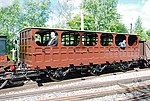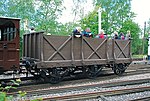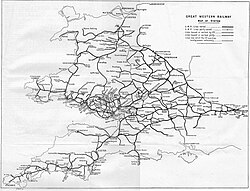Didcot Railway Centre
 | |
| Established | 1967 |
|---|---|
| Location | Didcot, Oxfordshire, England |
| Coordinates | 51°36′49″N 1°14′41″W / 51.613509°N 1.244772°W |
| Type | Operational Railway museum |
| Key holdings | GWR 6000 Class No.6023 King Edward II GWR 4073 Class No.4079 Pendennis Castle GWR Firefly Class Firefly |
| Owner | Great Western Society (site leased from Network Rail) |
| Public transit access | Didcot Parkway |
| Website | Didcot Railway Centre |
Didcot Railway Centre is a railway museum and preservation engineering site in Didcot, Oxfordshire, England. The site was formerly a Great Western Railway engine shed and locomotive stabling point.
Background
[edit]The founders and commercial backers of the Great Western Railway (GWR) supported Isambard Kingdom Brunel's scheme to develop an integrated railway and steamship service which allowed trans-Atlantic passengers and freight quicker passage between London and New York City. However, whilst backing the scheme the railway had to make a profit, and so it took a number of detours and added both mainline and branch line traffic to increase its domestic earnings. This earned the railway the nickname The Great Way Round from its detractors.[1]
Whilst the route from London Paddington to Reading was relatively straight, the then obvious most direct route to Bristol would have taken the railway further south, thus avoiding both Didcot and Swindon. However, passenger and freight traffic both to and from Oxford and onwards to the West Midlands in part dictated a more northerly route. Also, Brunel had originally planned to cut through Savernake Forest near Marlborough, Wiltshire to Bristol, but the Marquess of Ailesbury, who owned the land, objected – having previously objected to part of the Kennet and Avon Canal running through his estate (see Bruce Tunnel). With the railway needing to run near to a canal at its midpoint – as it was cheaper to transport coal for trains along canals at this time – and with the need for the branch northwards to Cheltenham via Stroud, Swindon was the next logical choice for the junction (and later railway works), 20 miles (32 km) north of the original route. This dictated that the Oxford junction also be moved northwards, and hence via Didcot.[1] The Great Western Railway built the first rail line through Didcot in 1839 and opened its first station in 1844.
Construction
[edit]
Due to the technical operational difficulties of running and maintaining a mainline service from London to Bristol, as well as the need for servicing locomotives going to Oxford, Didcot became an obvious midpoint maintenance and stabling point. Having built a timber-framed 7 ft 1⁄4 in (2,140 mm) broad gauge shed on the original site during the railway's development west in the 1800s, in June 1932 a new steel-framed half-brick 4-road through shed (210 by 67 feet [64.01 m × 20.42 m]), was completed by the GWR under the Loans and Guarantees Act (1929). With shed code DID, it also included a repair shop (84 by 42 feet [25.6 m × 12.8 m]), coaling stage (43 by 36 feet [13.1 m × 11.0 m]), sand furnace (10 by 10 feet [3.0 m × 3.0 m]) and 65 feet (20 m) turntable and associated offices (210 by 15 feet [64 m × 5 m]).[1] During World War II, a standard steel-framed with corrugated iron-panel covered ash shelter was erected:[1] this was dismantled in early GWS days.
Operations
[edit]After World War II, the site remained virtually unchanged during the nationalised ownership of British Railways (BR), but for taking on the new code of 81E. The standard allocation of locomotives remained the same, with Halls, Dukedogs and Panniers making up the bulk of the depot's fleet.[1]
Closure
[edit]With the replacement of steam with diesel traction under the Modernisation Plan, the shed became redundant and was closed in June 1965.[1]
Formation and site lease
[edit]The Great Western Society (GWS) was offered the use of the former Didcot locomotive depot, taking it over in 1967. In the 1970s, the society negotiated a long-term lease with BR which was to expire in 2019. But this was subject to a six-month termination clause which could force the GWS to quit the site, and which could be operated at any point in time by lease-holder Network Rail (NR).
In an attempt to secure a long-term future for the society, in 2002 the GWS opened negotiations with NR to either purchase the site or extend the lease. In a letter dated May 2007, NR informed the GWS that they were prepared to sell the site subject to Office of Rail Regulation (ORR) approval. It had been thought the site could be subject to need as a depot, either due to: the rebuilding of Reading station; a Crossrail project depot; or the Intercity Express Programme. After expressing some concern at the slow speed of negotiations at the GWS annual meeting in September 2008, NR wrote to the GWS to advise that the site was no longer available for sale, and although a lease extension was still on offer it was still subject to the previous six-month termination clause. The GWS then wrote to their local MP Ed Vaizey, and placed any long-term development plans on hold.[2] As of 6 October 2011[update] Richard Croucher (Chairman of the Great Western Society) signed a new 50-year lease with Network Rail, therefore preserving the site for at least another 50 years.
Museum and railway centre
[edit]


Today the GWS have developed the site, which still retains many of the original GWR buildings and features, as both a working steam locomotive and railway museum, engineering maintenance centre, and railway line offering short rides to visitors.
Access via Didcot Parkway station brings the visitor into the southern end of the site, at the start of the ramp coal wagons would take up to the coaling stage. Beyond this is the original 1932 four-road engine shed, and beyond this the original repair shed and 1988 constructed locomotive works, both of which have restricted access due to safety concerns. Beyond this lies a Ransomes & Rapier 70 feet (21 m) turntable, originally built for the Southern Railway at Southampton Docks, installed in the original pit.
The centre regularly holds events such as steam and diesel railcar days. Members of the Great Western Society have been active in the preservation of locomotives and rolling stock. Certain 'new-build' projects to create locomotives that did not escape wholesale scrapping have also been undertaken at Didcot, such as the completed Firefly locomotive, a 'Saint' class (using a 'Hall' class chassis and boiler) and a 'County' class locomotive (using a 'Hall' class chassis and an LMS '8F' class boiler).
There is a small relics museum and archive on site, operated by the Great Western Trust.[3]
The Railway Centre is used a period film set and has featured in works including Anna Karenina, Sherlock Holmes: A Game of Shadows, and The Elephant Man.[4]
Running lines
[edit]

There are three short lengths of running track, each with a station at both ends:
Branchline
[edit]This starts at a typical GWR wayside halt, named Didcot Halt, and runs north on the western edge of the site to a platform, named Burlescombe Station, at the transshipment shed. Dating from broad gauge days, the shed was used for transferring goods from broad to "narrow" (i.e. 4 ft 8+1⁄2 in or 1,435 mm standard gauge) rolling stock and vice versa. It was moved to its present location carefully from its original site nearby.
Broad Gauge Line
[edit]The broad gauge line of 7 ft 1⁄4 in (2,140 mm) starts from the transshipment shed, and runs halfway back down the branchline. The 2005 replica GWR Fire Fly is housed within the shed when not running
Mainline
[edit]Starting from the Main Line Platform opposite the site entrance, using a pre-fabricated concrete station platform from Eynsham, this runs on the eastern edge of the site to a newly built platform, named Oxford Road Station, near the transshipment shed. The reconstruction of the Brunel-designed building from Heyford station on this platform has been commenced.
Access
[edit]Railways around Didcot | |||||||||||||||||||||||||||||||||||||||||||||||||||||||||||||||||||||||||||||||||||||||||||
|---|---|---|---|---|---|---|---|---|---|---|---|---|---|---|---|---|---|---|---|---|---|---|---|---|---|---|---|---|---|---|---|---|---|---|---|---|---|---|---|---|---|---|---|---|---|---|---|---|---|---|---|---|---|---|---|---|---|---|---|---|---|---|---|---|---|---|---|---|---|---|---|---|---|---|---|---|---|---|---|---|---|---|---|---|---|---|---|---|---|---|---|
| |||||||||||||||||||||||||||||||||||||||||||||||||||||||||||||||||||||||||||||||||||||||||||
The railway centre is entirely surrounded by active railway lines and has no road connection of any kind. Public access is on foot from a subway at Didcot Parkway station, which links the centre by rail to London and much of southern and central England. Wheelchair and pram access has been difficult due to the presence of a flight of concrete steps on Network Rail property. To comply fully with the Disability Discrimination Act, the Great Western Society constructed a ramped access in 2023–24.[5]
Collection
[edit]Steam locomotives
[edit]| Class | Number (& Name) | Image | Status | Notes |
|---|---|---|---|---|
| Robert Stephenson and Hawthorns 0-4-0ST | No.1 Bonnie Prince Charlie |
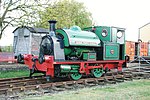
|
Static Display | Built 1949 for dockside shunting. Awaiting overhaul. Painted in lined light green livery.[6] |
| George England 0-4-0WT | No.5 | 
|
Static Display | Built 1857, latterly owned by the Wantage Tramway. Steamed in 1970s but examination indicated that too much historic material would need replacing to return it to working condition, so remains on static display in 1920s red livery.[7] |
| GWR Steam Railmotor | No.93 | 
|
Static Display | Built 1908. Restoration completed in 2012. Often runs with trailer carriage No. 92. Boiler ticket expired in 2021.[8] |
| GWR 1000 Class | 1014 County of Glamorgan |
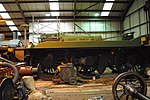
|
Under Construction | 1946 design. Replica using original GWR and LMS locomotive components.[9] |
| Kitson & Co. 0-4-0ST | No.1338 | 
|
Static Display | Built 1898. Ex-Cardiff Railway.[10] |
| GWR 1340 Class | 1340 Trojan |

|
Operational. | Built 1897. Ex-Alexandra (Newport and South Wales) Docks and Railway. Painted in GWR green livery. Returned to steam in 2021 after an offsite overhaul. [11][12] |
| GWR 1361 Class | 1363 | 
|
Under Overhaul | Built 1910. Undergoing a major overhaul with significant work being undertaken on both the boiler and frames.[13] |
| GWR 1400 Class | 1466 | 
|
Under Overhaul[14] | Built 1936. This was the first locomotive bought by the society. Under overhaul offsite and hoped to be back in service in 2024.[15] |
| Hunslet 0-6-0T | No. 2409 King George |

|
Operational | Built 1942 as 0-6-0ST for colliery use; rebuilding as 0-6-0T at Didcot completed 2022.[16] |
| GWR 2900 Class | 2999 Lady of Legend |

|
Operational | 1902/06 design. Completed at Didcot 2019[17] using components from No. 4942 Maindy Hall (1929). Runs as a 4-6-0 but intended to run as a 4-4-2 for periods of time.[18] |
| GWR 5700 Class | 3650 | 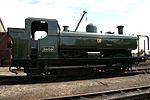
|
Under Overhaul | Built 1939. Ten-yearly overhaul began in 2018.[19] |
| GWR 5700 Class | 3738 | 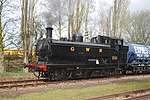
|
Static Display | Built 1937. Out of service from 2013 due to boiler crack.[20] |
| GWR 2884 Class | 3822 | 
|
Static Display | Built 1940. Appeared in the Queen music video Breakthru. Withdrawn from service in 2010.[21] |
| GWR 4073 Class | 4079 Pendennis Castle |

|
Operational | Built 1924. Boiler ticket expires 2031. This locomotive was repatriated from Australia in 2000 after spending 22 years in the country.[22] |
| GWR 5101 Class | 4144 | 
|
Operational | Built 1946. Boiler ticket expires in 2025. |
| GWR 4073 Class | 5051 Earl Bathurst |

|
Static Display | Built 1936. Currently carrying its former name, Drysllwyn Castle.[23] |
| GWR 5205 Class | 5227 | 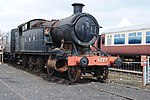
|
Static Display | Built 1924. One of the Barry Ten, it was purchased in 2010 to provide parts for the construction of the new-build GWR 4700 Class No. 4709. After donating its axleboxes to the project, it moved to Didcot in 2013 following storage at a private site. Currently on display in ex-scrapyard condition as a reminder of the challenge that preservationists had to conquer. The Standard No. 4 Boiler, pony truck wheel set, 2 pony truck axleboxes, 4 horn guides and 2 eccentric sheaves are being transferred to the new build Churchward County GWR 3800 Class 3840 "County of Montgomery".[24]The remainder of the locomotive has been sold to an individual who intends to restore the locomotive to working order, including manufacture of parts to replace those removed for use in new build projects. The locomotive is expected to remain at Didcot Railway Centre. [1] |
| GWR 4300 Class | 5322 | 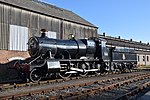
|
Static Display[25] | Built 1917. Used by Railway Operating Division in France during World War I. Withdrawn in 2014 due to boiler problems.[26] |
| GWR 4575 Class | 5572 | 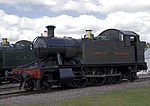
|
Static Display | Built 1929.[27] |
| GWR 4900 Class | 5900 Hinderton Hall |
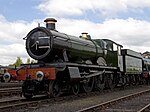
|
Static Display | Built 1931.[28] |
| GWR 6000 Class | 6023 King Edward II |
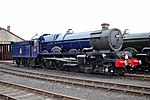
|
Static Display | Built 1930. Returned to steam in 2010 after completion of a lengthy restoration from scrapyard condition, was originally purchased as a spares donor for sister engine 6024 King Edward I. Boiler ticket expired in 2020.[29] BR blue livery. |
| GWR 6100 Class | 6106 | 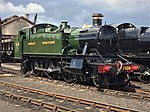
|
Static Display | Built 1931.[30] |
| GWR 5600 Class | 6697 | 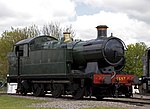
|
Static Display | Built 1928. Only member of the 5600 class to be purchased directly from British Railways for preservation.[31] |
| GWR 6959 Class | 6998 Burton Agnes Hall |

|
Static Display | Built 1949.[32] |
| GWR 7200 Class | 7202 | 
|
Under Restoration | Built 1934.[33] |
| GWR 7800 Class | 7808 Cookham Manor |
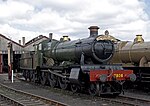
|
Static Display | Built 1938.[34] |
| GWR Firefly Class | Fire Fly | 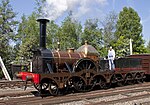
|
Static Display | Built 2005 as working replica of 1840 Broad Gauge 2-2-2.[35] |
| GWR Iron Duke Class | Iron Duke | 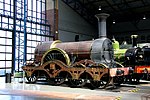
|
Static Display | Built 1985 as working replica of early Broad Gauge 4-2-2. On loan from National Railway Museum. |
| Breakdown Crane | RS1054 | 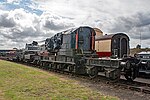
|
Under restoration | Built 1930. Ex LMS Cowan Sheldon 50 ton steam crane. |
| Steam Crane | 23059 | 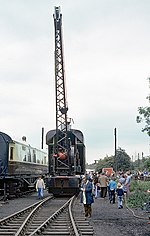
|
For restoration | Built 1954 by Thomas Smith and Sons (Rodley) Ltd, Leeds. |
Diesel locomotives
[edit]Including other non-steam powered vehicles
| Class | Number (&Name) | Image | Status | Notes |
|---|---|---|---|---|
| GWR Railcar | No.22 | 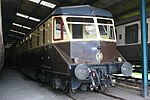
|
Operational | Built at Swindon in 1940.[36] |
| Hunslet | DL 26 | 
|
Operational[37] | Built by Hunslet of Leeds in 1957 for the National Coal Board and arrived at Didcot in 1978. It was the only diesel shunter at the site for many years until the arrival of 08604. Most of its duties tend to be light shunting. Repainted 2023. |
| British Rail Class 08 | 08604 Phantom |
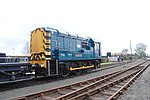
|
Operational[38] | Built at Derby Works as D3771, allocated to: Longsight (9A) June 1959; Stockport Edgeley (9B) July 1959; Longsight (9A) April 1965, unofficially named Ardwick; renumbered 08604 February 1974; stored Swindon Works 1981; Tyseley TMD February 1984, unofficially renamed Javelin, officially then named Phantom; Bescot November 1988; Derby Etches Park November 1992; withdrawn in July 1993. Sold to GWS and moved to DRC 1994. |
| British Rail Class 14 diesel-hydraulic | D9516 | 
|
Operational | Built at Swindon in 1964. After a post-BR industrial career, bought for preservation by Gerald Boden and based at Great Central Railway and then Nene Valley Railway. Bought from the Wensleydale Railway in 2014. |
| British Rail Class 52 diesel hydraulic | D1023 Western Fusilier |

|
Static Display | Built at Swindon in 1963. In 1973 it became the final diesel hydraulic to receive a general repair at Swindon Works. Upon withdrawal in 1977, it was preserved by the National Railway Museum. Arrived at Didcot in January 2023 on a 5 year loan from York.[39] |
| GWR 18000 gas turbine | 18000 | 
|
Static Display | Built by Brown, Boveri & Cie in Switzerland in 1949 to GWR order. Arrived 29 July 2011. Owned by Pete Waterman[40] |
| British Railways Wickham trolley | B42W | 
|
Operational | Built 1956. Type 27A Mk III Permanent Way Gang and inspection trolley. |
| Diesel Crane | CD24 | 
|
Operational | Built 1949 by Thomas Smith and Sons (Rodley) Ltd, Leeds. |
Other rolling stock
[edit]The GWS has an extensive supporting collection of GWR rolling stock, including three of the GWR Super Saloons that serviced the boat train traffic to Plymouth. In addition it has some vehicles for staff and maintenance use.
Carriages
[edit]| Type | Number (&Name) | Image | Status | Notes |
|---|---|---|---|---|
| Churchward Auto Trailer | No. 92 | 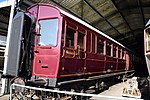
|
Restored to run with Steam Railmotor 93. | Built at Swindon, 1912. |
| Collett Auto Trailer | No. 190 | 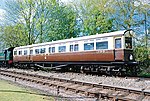
|
Operational, subject to works attention. | Built at Swindon, 1933. |
| Hawksworth Auto Trailer | No. 231 | 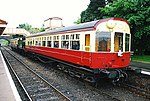
|
Operational, subject to works attention. | Built at Swindon, 1951 |
| Bristol & Exeter Railway Broad Gauge Coach | No. 250 | Enough of body remains to reconstruct a small compartment. | Built between 1852 & 1892 | |
| Dean 4w 1st 2nd Composite | No.290 | 
|
Restoration began in 2011. | Built at Swindon, 1902 |
| Dean 4w Brake Third | No. 416 | 
|
Built at Swindon, 1891 | |
| Collett Third | No. 536 | 
|
Operational | Built at Swindon, 1940 |
| Dean 4-Wheel Third | No. 975 | 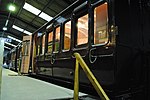
|
Restored | Built at Swindon, 1902. Restoration complete. Restored to recreate a Victorian train. |
| Collett Third | No. 1111 | No current restoration plans. | Built at Swindon, 1938. | |
| Collett 'Excursion' Third | No. 1289 | 
|
Built at Swindon,1937 | |
| Dean 8 Compartment Third Clerestory | No. 1357 | Awaiting major restoration in carriage shed. | Built at Swindon, 1903. | |
| Dean Third | No. 1941 | 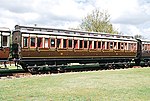
|
Operational. | Built at Swindon, 1901. |
| Hawksworth Brake Third | No. 2202 | 
|
Operational. | Built at Swindon, 1950 |
| Hawksworth Brake Third | No. 2232 | 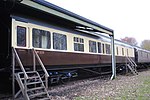
|
Initially restored as a locker room for staff. | Built at Swindon, 1950 |
| Dean 6-wheel Family Saloon | No. 2511 | 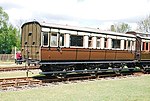
|
Operational. Was rescued and preserved from a house and placed on the underframe of a GWR 6-wheel van. | Built at Swindon, 1894 |
| Churchward “Dreadnought” 9 Compartment Third | No. 3299 | 
|
Major restoration commenced. | Built at Birmingham Railway Carriage and Wagon Company, 1905. One of the first coaches acquired by the Great Western Society. |
| Churchward Non-Corridor Brake Third | No. 3755 | 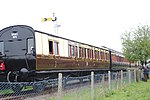
|
Restored and occasionally operated. | Built at Swindon, 1921. |
| Churchward Non-Corridor Brake Third | No. 3756 | 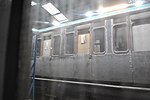
|
Under restoration. | Built at Swindon, 1921. |
| Churchward Toplight Corridor Third | No. 3963 | No current restoration plans. | Built at Swindon, 1919. | |
| Collett Third - Bow Ended | No. 4553 | 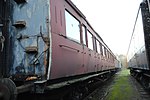
|
No current restoration plans. | Built at Swindon, 1925. |
| Collett 8 Compartment Bow-Ended Third | No. 5085 | Built at Swindon, 1928. | ||
| Collett Brake Third | No. 5787 | No current restoration plans. | Built at Swindon, 1933. | |
| Collett All Third | No. 5952 | 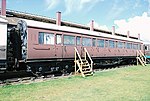
|
No current restoration plans; restoration may commence once 7371 is completed. | Built at Swindon, 1935. |
| Dean 6-Wheel Tricomposite | No. 6824 | Stored on an LMS 6w underframe. | Built in 1887. Was a convertible coach, originally built for the Broad Gauge. | |
| Collett Composite | No. 7285 | 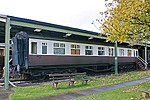
|
Built at Swindon, 1941. | |
| Collett Composite | No. 7313 | 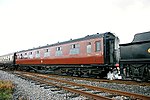
|
Restored. | Built at Swindon, 1940. Wartime all-over chocolate livery. |
| Collett Brake Composite | No. 7371 | Under restoration. | Built at Swindon, 1941. | |
| Hawksworth Brake Composite | No. 7372 | 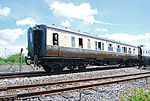
|
Operational | Built at Swindon, 1948. |
| Collett Brake Composite | No. 7976 | Built at Swindon, 1923. | ||
| Collett Special Saloon | No. 9002 | 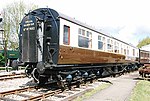
|
Operational. | Built at Swindon, 1940. Used by Winston Churchill, General Eisenhower and the Royal Family during WWII. |
| Hawksworth First Class Sleeping Car | No. 9083 | 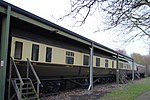
|
Operational, | Built at Swindon, 1951. |
| Collett Super Saloon | No. 9112 Queen Mary | No current restoration plans. | Built at Swindon, 1932. | |
| Collett Super Saloon | No. 9113 Prince of Wales | 
|
Under restoration | Built at Swindon, 1932. |
| Collett Super Saloon | No. 9118 Princess Elizabeth | 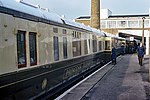
|
Built at Swindon, 1932. | |
| Dean Composite Diner | No. 9520 | No current restoration plans. | ||
| Collett 'Centenary Diner' | No. 9635 | 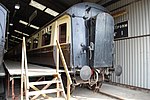
|
Built at Swindon, 1935. |
Broad Gauge replica carriages
[edit]Non-passenger-carrying coaching stock
[edit]| Type | Number (&Name) | Image | Status | Notes |
|---|---|---|---|---|
| Tool Van | No. 1 | 
|
In use as staff tool van. | Built in 1908 at Swindon. |
| Tool Van | No. 47 | 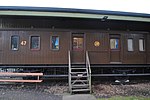
|
Stored under cover with 9083 and 2232, used as a stores van. | Built in 1908 at Swindon. |
| Tool Van | No. 56 | 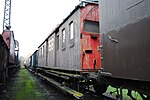
|
In use as staff tool van. | Built in 1908 at Swindon. |
| Collett Full Brake | No. 111 | 
|
No current restoration plans. | Built at Swindon, 1934. |
| Hawksworth Passenger Brake Van | No. 316 | 
|
Built at Swindon, 1950 | |
| Hawksworth Passenger Brake Van | No. 333 | 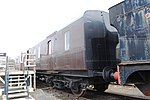
|
In use as sales vehicle. | Built at Swindon, 1951. Acquired from Gloucestershire and Warwickshire Railway. |
| Churchward 'Monster' Carriage Truck | No. 484 | Built at Swindon, 1913. | ||
| Churchward 'Python' | No. 565 | 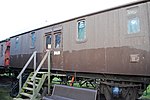
|
In use as a workshop and stores vehicle. | Built at Swindon, 1914. |
| Travelling Post Office | No. 814 | 
|
Not currently operational. | Built at Swindon, 1940. |
| Dean Full Brake | No. 933 | 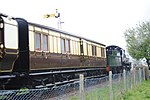
|
Operational by 2019. | Built at Swindon, 1898 |
| Medical Officers' Coach, originally a Churchward Passenger Brake Van - Toplight | No. 1159 | Built at Swindon, 1925. | ||
| Collett Full Brake | No. 1184 | 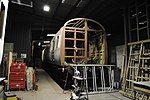
|
Being restored and modified to run with GWR TPO 814. | Built at Swindon, 1930. Last bow-ended full brake. |
| Collett 'Siphon G' | No. 2796 | 
|
Restored. Operational | Built at Swindon, 1937. |
| Six-Wheel Milk Tank | S4409 | 
|
Operational | Built in 1931 as four wheeler. Rebuilt in 1937 as six wheeler. Chassis ex-Southern Railway. Most recently painted in Co-operative Wholesale Society green livery with lettering "MILK C.W.S SERVICE". |
| Special Cattle Van | No. 752 | 
|
Restored | Built in 1952 at Ashford. Diagram W17. |
| 'Bloater' Fish Van | No. 2671 | 
|
Restored | Built in 1925 at Swindon. |
| 'Fruit C' Van | No. 2862 | 
|
Part restored | Built in 1939 at Swindon. |
| 'Fruit D' Van | No. 2913 | Built in 1941 at Swindon. | ||
| 'Fruit' Van | No. 47886 | 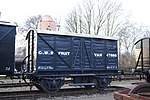
|
Operational. | Built in 1892 at Swindon. Dean brake system. |
| 'Mink G' fitted goods van | No. 112843 | 
|
Restored. | Built in 1931 at Swindon. |
Wagons
[edit]| Type | Number (&Name) | Image | Status | Notes |
|---|---|---|---|---|
| Tar Wagon | No. 1 | Requires re-restoration | Built in 1898 | |
| 6w Drinking Water Tank | No. 101 | 
|
Stored | Built in 1948. |
| Department Mess Van | No. 263 | 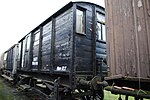
|
In staff use | Built in 1905. Rebuilt by BR from a GWR 25t brake van No. 56867. |
| Oil Tank Wagon | No. 795 | 
|
Restored | Built in 1912 by Hurst Nelson. Most recently painted as Anglo American Oil Co Ltd - Pratts Perfection Spirit. Previously restored as Royal Daylight No. 745. |
| 'Rotank' flat wagon carrying trailer tank | No. 3030 | 
|
Restored | Built in 1947 at Swindon. Most recently painted as Simonds Beer tank. |
| Goods Van | No. 516673 | 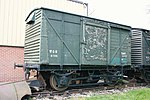
|
Restored, used for storage | Ex-LMS. Purchased from MoD Bicester as 4166 for storage by the locomotive department. Stored beside locomotive workshop at the end of line of unrestored stock. |
| Goods Van | No. 517791 | 
|
Restored, used for storage | Ex-LMS. Purchased from MoD Bicester as 4167 for storage by the locomotive department. Stored beside locomotive workshop at the end of line of unrestored stock. |
| Four wheel 7-plank mineral wagon | No. 10153 | 
|
Restored | Built by Gloucester RCW. Ex-Taff Vale Railway, only surviving TVR wagon. Most likely 1880s because of the handbrake gear. |
| Iron Mink | No. 11152 | 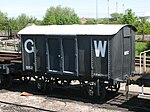
|
Restored, non-operational | Built in 1900 at Swindon. |
| "Toad" Brake Van | No. 17447 | 
|
Part dismantled, stored under tarpaulin | Built in 1940 at Swindon. |
| 4 wheel 5-plank open wagon | No. 18553 | 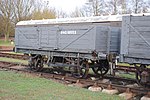
|
Operational | Built in 1927 by Sheffield C&W. |
| "Open A" open wagon | No. 19818 | 
|
Restored | Built in 1917 at Swindon. |
| 'Mite' Single Bolsters | Nos. 32337 & 32338 | 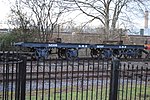
|
Non-operational | Built in 1881 at Swindon. |
| 'Coral A' crated glass wagon | No. 41723 | 
|
Awaiting restoration | Built in 1908 at Swindon. |
| 20/21ton Loco Coal wagon | No. 63066 | 
|
Restored | Built in 1946 at Swindon. |
| 'Pollen E' | Nos 84997-85000 | 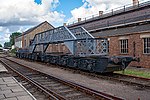
|
Restored, on loan from National Railway Museum | Built in 1909 at Swindon. |
| 'Macaw B' bogie bolster wagon | No. 70335 | 
|
Restored | Built in 1939 at Swindon. |
| 'Crocodile F' bogie well trolley | No. 41934 | 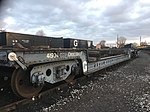
|
Operational | Built in 1908 at Swindon as Crocodile G, modified 1909 as Crocodile F, Diagram C12. Now rare. |
| 'Hydra D' machinery wagon | No. 42193 | 
|
Stored in open | Built in 1917 at Swindon. Now rare. |
| Grain Wagon | No. 42239 | 
|
Stored under tarpaulin awaiting re-restoration | Built in 1927 at Swindon. |
| 'Loriot L' machinery wagon | No. 42271 | 
|
Operational | Built in 1934 at Swindon. |
| Creosote Tank Wagon | No. 43949 | 
|
Stored | Built in 1901 at Swindon. |
| 16ton 'Toad' brake van | No. 56400 | 
|
Stored amongst other stock in staff use | Built in 1900 at Swindon. Originally 14-ton but later 16-ton. Verandah is covered by inside tarpaulin for protection. |
| 20ton 'Toad' brake van | No. 68684 | 
|
Restored | Built in 1924 at Swindon. |
| 20ton 'Toad' brake van | No. 950592 | 
|
Restored | Built in 1950 at Swindon. |
| Mink A ventilated van | No. 101720 | 
|
Restored | Built in 1924 at Swindon. "Flour Traffic Only - Return to Wantage Road". |
| Mink A ventilated van | No. 101836 | 
|
Restored | Built in 1925 at Swindon. |
| Mink A ventilated van | No. 145428 | 
|
Restored | Built in 1944 at Swindon. |
| Mink A ventilated van | No. W146366 | 
|
Restored | Built in 1948 at Swindon. |
| Open A open wagon | No. 117993 | 
|
Restored | Built in 1930 at Swindon. |
| Open C open wagon | No. 94835 | 
|
Restored | Built in 1920 at Swindon. |
| Open wagon | No. 143698 | Built in 1945 at Swindon. | ||
| Clay wagon | No. 92943 | 
|
Restored | Built in 1913 at Swindon. |
| 'Tevan' perishable traffic van | No. 79933 | 
|
Restored | Built in 1922 at Swindon; converted 1938 from 'Mica B' refrigerated meat van. |
| 'Mica B' refigerated meat van | No. 105860 | Restored | Built in 1925 at Swindon. | |
| "Fruit B" Banana Van | No. 1055993 | 
|
Restored | Built in 1929 at Swindon. |
| 'Mogo' Motor Car Goods Van | No. 1055993 | 
|
Restored | Built in 1936 at Swindon. |
| 'Asmo' Motor Car Van | No. 116954 | Built in 1930 at Swindon. | ||
| 'Cone' Gunpowder Van | No. 105781 | 
|
Restored | Built in 1939 at Swindon. |
| Shunters' truck | No. 100377 | 
|
Operational | Built in 1953 at Swindon, converted from underframe of 'Mink A' van. |
| Ballast wagon | No. 80659 | 
|
Operational | Built in 1936 at Swindon. |
| Ballast wagon | No. 80668 | 
|
Operational | Built in 1936 at Swindon. |
| Ballast wagon | No. 80789 | 
|
Operational | Built in 1937 at Swindon. |
| Chaired sleeper wagon | No. 100682 (GWS 91200) | 
|
Operational | Built in 1939 at Swindon. |
| Hand crane and match truck | No. 205 | 
|
Restored, non-operational | Built in 1894 at Swindon. |
| Hand crane | No. 537 | 
|
Restored, non-operational | Built in 1899 at Swindon. |
| Pooley mobile workshop van | No. 82917 | 
|
In staff use | Built in 1911 at Swindon as standard covered van; rebuilt 1934 for use of Henry Pooley & Co., the GWR's maintenance contractor for weighbridges. |
| Demountable beer tank wagon, displayed as aircraft propeller wagon | No. B749039 | 
|
Restored, non-operational | Built in 1951 at Shildon. |
| 2 ft gauge slate wagon | No. 67 (?) | 
|
Under restoration | Built in 1903 at Swindon. Used for traffic from Manod to Blaenau Festiniog. |
References
[edit]- ^ a b c d e f E.T. Lyons (1979). An Historical Survey of Great Western Engine Sheds: 1837–1947. Oxford Publishing. ISBN 086093019X.
- ^ "Latest news – Didcot Railway Centre". Didcotrailwaycentre.org.uk. Retrieved 7 August 2012.
- ^ "Great Western Trust Museum & Archive". Didcot Railway Centre. Retrieved 23 September 2023.
- ^ "Didcot is 'most normal town in England', researchers claim". BBC News. 29 March 2017. Retrieved 10 May 2017.
- ^ "Entrance Ramp - First Concrete Pour". Didcot Railway Centre. Retrieved 17 February 2024.
- ^ No. 1 – Bonnie Prince Charlie. Didcotrailwaycentre.org.uk (2007-12-25). Retrieved on 2011-03-02.
- ^ No.5 – Shannon/Jane. Didcotrailwaycentre.org.uk (2010-07-11). Retrieved on 2011-03-02.
- ^ "93 - Steam Railmotor | Didcot Railway Centre". didcotrailwaycentre.org.uk. Retrieved 27 January 2023.
- ^ https://didcotrailwaycentre.org.uk/article.php/57/1014-county-of-glamorgan 1014 County of Glamorgan
- ^ 1338 – 0-4-0ST. Didcotrailwaycentre.org.uk (2010-11-01). Retrieved on 2011-03-02.
- ^ "1340 - Trojan". Didcot Railway Centre. Retrieved 7 April 2021.
- ^ "Trojan returns as the oldest working GWR locomotive". Heritage Railway. No. 280. 14 May 2021. p. 26.
- ^ https://didcotrailwaycentre.org.uk/article.php/60/1363-1361-class 1363
- ^ "1466/4866". Didcot Railway Centre. 3 July 2013. Retrieved 8 February 2015.
- ^ "News Archive - 2013". Didcot Railway Centre. Didcot. 1466 'Now available in Black'. Archived from the original on 19 February 2018. Retrieved 8 February 2015.
- ^ https://didcotrailwaycentre.org.uk/article.php/62/2409-king-george 2404 King George
- ^ "Didcot Railway Centre".
- ^ "2999 Lady of Legend – The Saint Project: the Atlantic Option". Archived from the original on 26 April 2012.
- ^ https://didcotrailwaycentre.org.uk/article.php/64/3650-57xx-class 3650
- ^ https://didcotrailwaycentre.org.uk/article.php/65/3738-57xx-class 3738
- ^ https://didcotrailwaycentre.org.uk/article.php/66/3822-2884-class 3822
- ^ https://didcotrailwaycentre.org.uk/article.php/67/4079-pendennis-castle 4079 Pendennis Castle
- ^ https://didcotrailwaycentre.org.uk/article.php/70/5051-drysllwyn-castle-earl-bathurst 5051 Drysllwyn Castle
- ^ "Home". Churchward County Trust. Retrieved 14 March 2022.
- ^ "5322". Didcot Railway Centre. Retrieved 8 February 2015.
- ^ https://didcotrailwaycentre.org.uk/article.php/72/5322-43xx-class 5322
- ^ https://didcotrailwaycentre.org.uk/article.php/73/5572-4575-class 5572
- ^ https://didcotrailwaycentre.org.uk/article.php/74/5900-hinderton-hall 5900 Hinderton Hall
- ^ https://didcotrailwaycentre.org.uk/article.php/75/6023-king-edward-ii 6023 King Edward II
- ^ https://didcotrailwaycentre.org.uk/article.php/76/6106-61xx-class 6106
- ^ https://didcotrailwaycentre.org.uk/article.php/77/6697-56xx-class 6697
- ^ https://didcotrailwaycentre.org.uk/article.php/78/6998-burton-agnes-hall 6998 Burton Agnes Hall
- ^ https://didcotrailwaycentre.org.uk/article.php/79/7202-72xx-class 7202
- ^ https://didcotrailwaycentre.org.uk/article.php/80/7808-cookham-manor 7808 Cookham Manor
- ^ Fire Fly – 2-2-2. Didcotrailwaycentre.org.uk (2010-11-27). Retrieved on 2011-03-02.
- ^ https://didcotrailwaycentre.org.uk/article.php/83/22-diesel-railcar GWR Railcar No.22
- ^ "DL 26". Didcot Railway Centre. 20 October 2007. Archived from the original on 2 August 2016. Retrieved 11 March 2018.
- ^ "08 604 "Phantom"". Didcot Railway Centre. 19 August 2010. Archived from the original on 9 October 2017. Retrieved 8 February 2015.
- ^ "A Western locomotive for Didcot". Didcot Railway Centre. 28 January 2023. Retrieved 29 January 2023.
- ^ "News | Latest News". Didcot Railway Centre. Retrieved 7 August 2012.
External links
[edit]Didcot Railway Centre.
- Official website
- Listed building information:
- Map sources for Didcot Railway Centre


